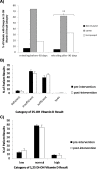Reducing overutilisation of serum vitamin D testing at a tertiary care centre
- PMID: 32098778
- PMCID: PMC7047492
- DOI: 10.1136/bmjoq-2020-000929
Reducing overutilisation of serum vitamin D testing at a tertiary care centre
Abstract
Introduction: Testing of 25-hydroxy (25-OH) vitamin D serum levels has increased drastically in recent years and much of it is considered inappropriate based on current guidelines.
Methods: In consultation with our physician groups (experts and frequent orderers), we modified existing guidelines and implemented a rational policy for 25-OH vitamin D testing and 1,25 dihydroxy (1,25 di-OH) vitamin D testing at a tertiary care centre. A computer decision support tool requiring selection of one of five acceptable testing indications was created for each test as part of a computerised physician order entry system.
Results: As a result of our intervention, we observed a 27% decrease in the average monthly test volume for 25-OH vitamin D from 504±62 (mean±SD) tests per month to 370±33 (p<0.001). 1,25 di-OH vitamin D testing decreased 58% from 71±18 to 30±10 (p<0.001). The departments ordering the tests were similar during the preintervention and postintervention periods, and further audits, patient chart reviews and individualised physician feedback were required to ensure appropriate ordering of 1,25 di-OH vitamin D. The most common ordering reasons selected were malabsorption/dietary concerns (46%) for 25-OH vitamin D and renal failure (42%) for 1,25 di-OH vitamin D.
Conclusions: Limitations of our computer decision support tool include a dependence on an honour system in selecting the testing indication and an inability to limit ordering frequency. Periodic monitoring of test volumes will be required to ensure adherence to guidelines. Despite these limitations, we have improved appropriate utilisation of these tests and reduced costs by approximately $C60 375 per year.
Keywords: test utilization; vitamin D.
© Author(s) (or their employer(s)) 2020. Re-use permitted under CC BY-NC. No commercial re-use. See rights and permissions. Published by BMJ.
Conflict of interest statement
Competing interests: None declared.
Figures






References
-
- Ministry of Health and Long-Term Care [Internet] Ontario: Ministry of Health and Long-Term Care; c2010 [cited 2018 Sep 11]. Understanding changes to OHIP coverage of vitamin D testing. Available: http://www.health.gov.on.ca/en/public/programs/ohip/changes/docs/MOH_Vit...
-
- BCGuidelines.ca [Internet] Victoria: Guidelines and Protocols Advisory Committee; c2010-2013 [cited 2018 Sep 12]. Vitamin D testing protocol. Available: https://www2.gov.bc.ca/gov/content/health/practitioner-professional-reso...
MeSH terms
Substances
LinkOut - more resources
Full Text Sources
Medical
Research Materials
